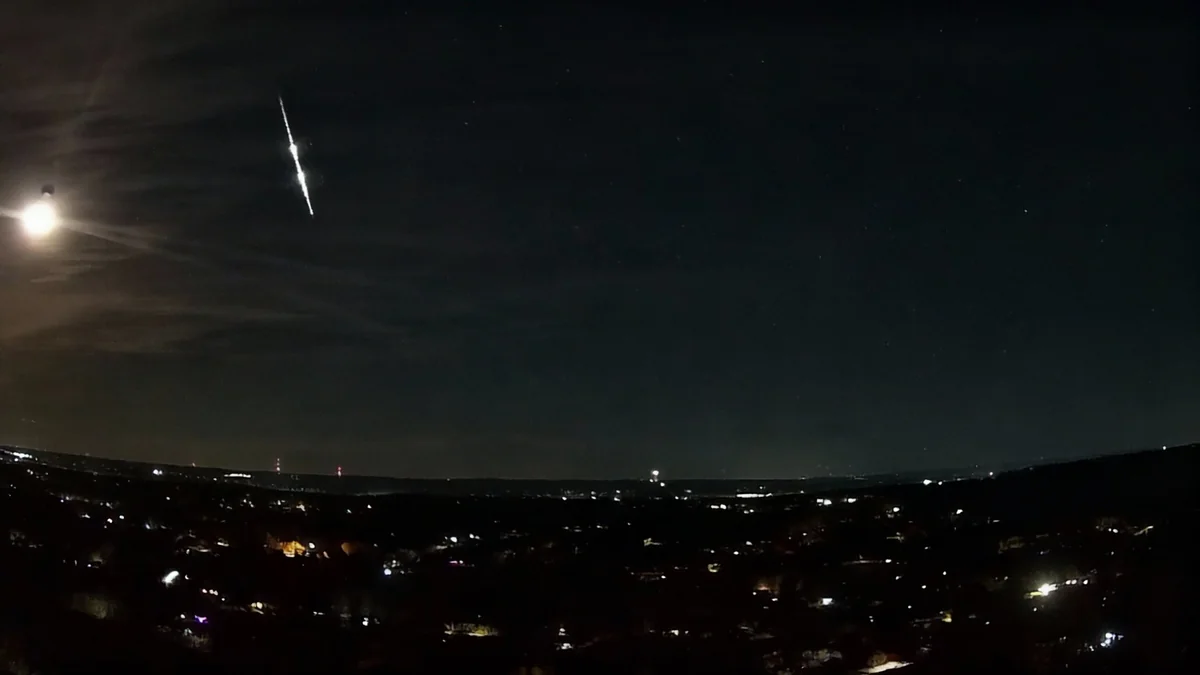Skywatchers have the opportunity to witness two concurrent meteor showers, the Southern and Northern Taurids, which are now active. These annual celestial events are known for producing an increased number of exceptionally bright meteors, known as fireballs, with peak activity expected in early and mid-November.
Key Takeaways
- Two meteor showers, the Southern and Northern Taurids, are currently active.
- The Southern Taurids will peak on the night of November 4-5, 2025.
- The Northern Taurids are set to peak on the night of November 11-12, 2025.
- Both showers originate from debris left by Comet 2P/Encke and are famous for producing bright fireballs.
- Viewers can expect to see up to 5 meteors per hour from each shower during their respective peaks under ideal conditions.
Understanding the Taurid Meteor Streams
The Taurid meteor shower is not a single event but two separate streams of cosmic debris that Earth passes through each year. These are known as the Southern Taurids and the Northern Taurids. While they have different peak dates, their activity periods overlap, creating a prolonged season of meteor activity throughout October and November.
Both showers appear to radiate from the constellation Taurus, the Bull. This is why they are named the Taurids. To locate Taurus, observers can look to the eastern sky in the late evening hours, where the constellation will be rising.
A Shared Cosmic Origin
The source of both the Northern and Southern Taurid streams is Comet 2P/Encke. This comet has one of the shortest orbital periods of any known comet, circling the sun once every 3.3 years. As it travels, it leaves behind a wide trail of dust and small rocky particles. When Earth's orbit intersects this debris field, the particles enter our atmosphere at high speed and burn up, creating the streaks of light we call meteors.
Key Dates for Viewing the 2025 Taurids
While both showers are active for several weeks, they each have a specific night of peak activity when the highest number of meteors is expected. The hourly rate for both showers is modest, typically around five meteors per hour, but the quality of these meteors often makes up for the low quantity.
Southern Taurids: Early November Peak
The Southern Taurid meteor shower has been active since September 20. Its peak is predicted to occur on the night of November 4-5, 2025. Stargazers hoping to see this peak should be aware of a significant challenge: a nearly full moon will be present in the sky. The bright moonlight will likely wash out the fainter meteors, making them difficult to see. However, the brightest fireballs should still be visible.
Northern Taurids: Mid-November Peak
The Northern Taurid stream becomes active later, starting on October 20. Its peak activity is forecast for the night of November 11-12, 2025. Conditions for this peak may be more favorable, as the moon will be in a different phase and its light will be less intrusive. This provides a better opportunity to see both faint and bright meteors from this stream.
What is a Fireball?
A fireball is a term for an unusually bright meteor, specifically one that is brighter than the planet Venus as seen from Earth. They are created by larger pieces of debris, ranging from a few inches to several feet in diameter, burning up in the atmosphere. These spectacular events can briefly light up the entire sky and often leave a persistent, glowing trail behind them.
The Science Behind Taurid Fireballs
The Taurid streams are particularly well-known for their high concentration of fireballs. This reputation is due to the nature of the debris from Comet 2P/Encke. The particles within the Taurid stream are often larger and more substantial than the fine dust that makes up many other meteor showers.
According to the American Meteor Society, periods when both the Northern and Southern Taurid showers are active simultaneously have historically corresponded with a noticeable increase in fireball reports. The combined presence of both streams increases the chances of Earth encountering larger fragments from the comet's debris cloud.
When these pebble-sized or larger objects collide with Earth's atmosphere, the intense friction generates a tremendous amount of heat and light, resulting in the dramatic fireballs that can turn night into day for a fleeting moment. This makes the Taurid shower a prime target for both casual observers and astrophotographers.
How to Observe the Meteor Shower
Watching a meteor shower does not require any special equipment, but a few simple steps can greatly improve the experience. The most important factor is finding a location with a dark sky, far away from city lights that cause light pollution.
Follow these tips for the best viewing experience:
- Find a Dark Location: Travel as far from urban areas as possible. National parks or rural areas are ideal.
- Allow Your Eyes to Adapt: It takes about 20-30 minutes for your eyes to fully adjust to the darkness. Avoid looking at your phone or other bright screens during this time.
- Be Patient: Meteor watching involves waiting. The predicted rates are an average, and meteors often come in spurts with lulls in between.
- Look Towards Taurus: While meteors can appear anywhere in the sky, tracing their paths back will lead to the radiant point in the constellation Taurus. Facing this general direction can be helpful.
- Get Comfortable: Use a reclining chair or lie on a blanket to avoid neck strain from looking up for an extended period. Dress warmly, as temperatures can drop significantly overnight.
While the number of meteors may not be as high as other famous showers like the Perseids or Geminids, the Taurids offer a unique chance to witness a truly spectacular fireball. The extended activity period provides many opportunities for skywatchers to catch a glimpse of this celestial display.





